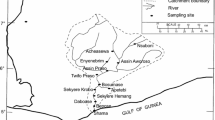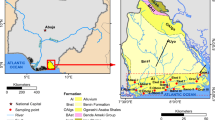Abstract
This study assessed the influence of geological depth and formation on activity concentrations of 232Th, 226Ra and 40K in soil and groundwater, and radio-chemical health risks. Preference ranking organisation method for enrichment evaluation and geometrical analysis for interactive aid indicated significant correlation between 232Th and 40K, thus indicating potential similar primordial origin. Deepest depth rocks at 145 m and 148 m constituted of dark coloured silicified schist exhibited minimal activity with potential hydro-geological interactions with groundwater. Age-dependent annual effective ingestion dose for 226Ra and 232Th are higher than the UNSCEAR reference dose, thus the groundwater is unsuitable for long-term consumption.


Similar content being viewed by others
References
IAEA (2019) IAEA Safety Glossary. Terminology Used in Nuclear Safety and Radiation Protection 2018 Edition. Vienna, Austria
Kritsananuwat R, Sahoo SK, Fukushi M, Pangza K, Chanyotha S (2014) Radiological risk assessment of 238U, 232Th and 40K in Thailand coastal sediments at selected areas proposed for nuclear power plant sites. J Radioanal Nucl Chem 303(1):325–334. https://doi.org/10.1007/s10967-014-3376-7
UNSCEAR (2000) Sources and effects of ionizing radiation. United Nations Scientific Committee on the Effects of Atomic Radiation. UNSCEAR 2000 Report to the General Assembly, with Scientific Annexes, vol 1. United Nations, New York
Langmuir D (1978) Uranium-solution equilibria at low temperatures with applications to sedimentary ore deposits. Geochim Cosmochim Acta 42:547–569
Ivanovich M, Harmon RS (1992) Uranium-series disequilibrium: applications to earth, marine, and environmental sciences, 2nd edn. Clarendon Press, London
Yii MW, Zaharudin A, Abdul-Kadir I (2009) Distribution of naturally occurring radionuclides activity concentration in East Malaysian marine sediment. Appl Radiat Isot 67(4):630–635. https://doi.org/10.1016/j.apradiso.2008.11.019
Doyi I, Essumang D, Gbeddy G, Dampare S, Kumassah E, Saka D (2018) Spatial distribution, accumulation and human health risk assessment of heavy metals in soil and groundwater of the Tano Basin, Ghana. Ecotoxicol Environ Saf 165:540–546. https://doi.org/10.1016/j.ecoenv.2018.09.015
Cothern CR, Lappenbusch WL (1983) Occurrence of uranium in drinking water in the U.S. Health Phys 45:89–99
ICRP (2012) Compendium of dose coefficients based on ICRP Publication 60. vol 41.
IAEA (2003) Scientific and technical basis for geological disposal of radioactive wastes. International Atomic Energy Agency, Vienna
IAEA (2011) IAEA Safety Standards for protecting people and the environment. Disposal of Radioactive Waste. International Atomic Energy Agency, Vienna
IAEA (2009) IAEA Safety Standards for protecting people and the environment. Borehole Disposal Facilities for Radioactive Waste. International Atomic Energy Agency, Vienna
Sumerling T, Smith P (1998) Disposal of nuclear fuel waste Geological alternatives, designs, implementation, and long term safety. Interdiscip Sci Rev 23(3):214–232. https://doi.org/10.1179/isr.1998.23.3.214
Mani R (1978) The geology of the Dahomeyan of Ghana. Geology of Ghana Project. vol 45. Ghana Geological Survey Bulletin,
Wright JB, Hastings DA, Jones WB, Williams HR (1985) Geology and mineral resources of West Africa. 1st edn. George Allen & Unwin (Publishers) Ltd, London. https://doi.org/10.1007/978-94-015-3932-6
Muff R, Efa E (2006) Explanatory Notes for the Geological Map for Urban Planning 1:50 000 of Greater Accra Metropolitan Area
Darko EO, Tetteh GK, Akaho EH (2005) Occupational radiation exposure to norms in a gold mine. Radiat Prot Dosimetry 114(4):538–545. https://doi.org/10.1093/rpd/nci300
Alomari AH, Saleh MA, Hashim S, Al-Hada N, Abukashabeh A, Alsayaheen A, Hamad M (2020) Radiological dose and health impact to Jordanian populace due to radioactivity in staple food crops from four representative soils in Jordan. J Radioanal Nucl Chem 326(3):1679–1689. https://doi.org/10.1007/s10967-020-07461-6
Darko EO, Faanu A, Awudu AR, Emi-Reynolds G, Yeboah J, Oppon OC, Akaho EH (2010) Public exposure to hazards associated with natural radioactivity in open-pit mining in Ghana. Radiat Prot Dosimetry 138(1):45–51. https://doi.org/10.1093/rpd/ncp181
Beretka J, Mathew PJ (1985) Natural radioactivity of Australian building materials, industrial wastes and by-products. Health Phys 48(1):87–95
Uosif MAM, Issa SAM, El-Salam LMA (2015) Measurement of natural radioactivity in granites and its quartz-bearing gold at El-Fawakhir area (Central Eastern Desert). Egypt J Radiat Res Appl Sci 8:1–6. https://doi.org/10.1016/j.jrras.2015.02.005
Gonzalez-Fernandez D, Garrido-Perez MC, Casas-Ruiz M, Barbero L, Nebot-Sanz E (2012) Radiological risk assessment of naturally occurring radioactive materials in marine sediments and its application in industrialized coastal areas: Bay of Algeciras, Spain. Environ Earth Sci 66:1175–1181. https://doi.org/10.1007/s12665-011-1325-0
Ravisankar R, Sivakumar S, Chandrasekaran A, Jebakumar JPP, Vijayalakshmi I, Vijayagopal P, Venkatraman B (2014) Spatial distribution of gamma radioactivity levels and radiological hazard indices in the East Coastal sediments of Tamilnadu, India with statistical approach. J Rad Phys Chem 103:89–98. https://doi.org/10.1016/j.radphyschem.2014.05.037
Ravisankar R, Sivakumar S, Chandrasekaran A, Anand DP, Jebakumar JPP, Vijayagopal P, Vijayalakshmi I, Jose MT (2014) Measurement of natural radioactivity and evaluation of radiation hazards in coastal sediments of east coast of Tamilnadu using statistical approach. J Taibah Univ Sci 8(4):375–384. https://doi.org/10.1016/j.jtusci.2014.03.004
NEA-OECD (1979) Exposure to radiation from natural radioactivity in building materials. Report by NEA group of Experts, Paris
Isinkaye MO, Agbi JI (2013) Natural radioactivity and associated radiation hazards of some commonly used building materials in southwest Nigeria. Radioprotection 48(3):355–365. https://doi.org/10.1051/radiopro/2013061
Arafa W (2004) Specific activity and hazards of granite samples collected from the Eastern Desert of Egypt. J Environ Radioact 75(3):315–327. https://doi.org/10.1016/j.jenvrad.2004.01.004
Gbenu ST, Oladejo OF, Olukotun SF, Makinde OW, Fasasi MK, Balogun FA (2016) Assessment of radioactivity and radiological hazards in commercial ceramic tiles used in Ife-Central, local government area of Osun State. Nigeria Egypt J Basic Appl Sci 3(4):377–382. https://doi.org/10.1016/j.ejbas.2016.08.002
ICRP (2007) The 2007 Recommendations of the International Commission on Radiological Protection.
Degerlier M, Karahan G (2010) Natural radioactivity in various surface waters in Adana. Turkey Desalination 261(1–2):126–130. https://doi.org/10.1016/j.desal.2010.05.020
WHO (2011) Guidelines for drinking-water quality -, 4th edn. World Health Organization (WHO), Geneva
Patra AC, Mohapatra S, Sahoo SK, Lenka P, Dubey JS, Tripathi RM, Puranik VD (2013) Age-dependent dose and health risk due to intake of uranium in drinking water from Jaduguda. India Radiat Prot Dosimetry 155(2):210–216. https://doi.org/10.1093/rpd/ncs328
Abbasi A, Mirekhtiary F (2019) Lifetime risk assessment of Radium in drinking water samples. Int J Radiat Res 17(1):163–169. https://doi.org/10.18869/acadpub.ijrr.17.1.163
Nasir T, Rafique M, Rehman Ju, Ahmad N (2018) Age-dependent annual effective dose estimations of 226Ra, 232Th, 40K and 222Rn from drinking water in Baling. Malays Water Supply 18(1):32–39. https://doi.org/10.2166/ws.2017.094
Arabi AM, Ahmed NK, Din KS (2006) Natural radionuclides and dose estimation in natural water resources from Elba protective area. Egypt Radiat Prot Dosim 121(3):284–292. https://doi.org/10.1093/rpd/ncl022
USEPA (1999) Cancer Risk Coefficients for Environmental Exposure to Radionuclides. Office of Radiation and Indoor Air, U.S. Environmental Protection Agency, Washington, DC
Giri S, Jha VN (2012) Risk assessment (chemical and radiological) due to intake of uranium through the ingestion of drinking water around two proposed uranium mining areas, Jharkhand, India. Radioprotection 47(4):543–551. https://doi.org/10.1051/radiopro/2012020
National Research Council N (1999) Risk Assessment of Radon in Drinking Water. The National Academies Press, Washington, DC. https://doi.org/10.17226/6287
WHO (2018) World health statistics 2018: monitoring health for the SDGs, sustainable development goals. World Health Organization, Geneva
Gbeddy G, Goonetilleke A, Ayoko GA, Egodawatta P (2020) Application of multivariate data techniques in photochemical study of polycyclic aromatic hydrocarbons (PAHs) and transformed PAH products in road dust. Ecotoxicol Environ Saf 196:110478. https://doi.org/10.1016/j.ecoenv.2020.110478
Kitto ME, Kim MS (2005) Naturally occurring radionuclides in community water supplies of New York State. Health Phys 88(3):253–260
Ayoko GA, Bonire JJ, Abdulkadir SS, Olurinola PF, Ehinmidu JO, Kokot S, Yiasel S (2003) A multicriteria ranking of organotin(IV) compounds with fungicidal properties. Appl Organometal Chem 17:749–758. https://doi.org/10.1002/aoc.520
Dugalic G, Krstic D, Jelic M, Nikezic D, Milenkovic B, Pucarevic M, Zeremski-Skoric T (2010) Heavy metals, organics and radioactivity in soil of western Serbia. J Hazard Mater 177(1–3):697–702. https://doi.org/10.1016/j.jhazmat.2009.12.087
Gbeddy GK (2020) Transformation and degradation of organic pollutants on urban road surfaces. Thesis by Publication, Queensland University of Technology, Queensland, Australia
IAEA (2016) Criteria for radionuclide activity concentrations for food and drinking water. IAEA, Vienna
Acknowledgements
The authors would like to express their profound appreciation to the Radiation Protection Institute of the Ghana Atomic Energy Commission for providing the enabling environment as well as some logistical support for this study. The authors also appreciate the support of the International Atomic Energy Agency (IAEA) in diverse ways including logistical and expert advisories.
Funding
This research did not receive any specific grant from funding agencies in the public, commercial or not-for-profit sectors.
Author information
Authors and Affiliations
Corresponding author
Ethics declarations
Conflict of interest
The authors declare that they have no conflict of interest.
Additional information
Publisher's Note
Springer Nature remains neutral with regard to jurisdictional claims in published maps and institutional affiliations.
Supplementary information
Below is the link to the electronic supplementary material.
Rights and permissions
About this article
Cite this article
Akortia, E., Glover, E.T., Nyarku, M. et al. Geological interactions and radio-chemical risks of primordial radionuclides 40K, 226Ra, and 232Th in soil and groundwater from potential radioactive waste disposal site in Ghana. J Radioanal Nucl Chem 328, 577–589 (2021). https://doi.org/10.1007/s10967-021-07675-2
Received:
Accepted:
Published:
Issue Date:
DOI: https://doi.org/10.1007/s10967-021-07675-2




